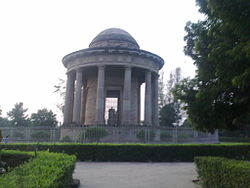This article needs
additional citations for verification. Please help improve this
article by adding citations to reliable sources. Unsourced material
may be challenged and removed.
Ghazipur (Hindi: ग़ाज़ीपुर, Urdu: غازیپور, previously spelled Ghazeepore, Gauspur, and Ghazipour), is a city and municipal
corporation in the state of Uttar Pradesh, India. Ghazipur city is
the administrative headquarters of the Ghazipur district, one of the four
districts that form the Varanasi division of Uttar Pradesh. The city
of Ghazipur also constitutes one of the five distinct tehsils, or
subdivisions, of the Ghazipur district.
Ghazipur is
well known for its opium factory, established by the British
East India Company in 1820 and still the biggest legal opium factory in
the world, producing the drug for the global pharmaceutical industry.[1]
Sights in
the city include several monuments built by Nawab Shaikh Abdulla, or Abdullah
Khan, a governor of Ghazipur during theMughal Empire in the eighteenth
century, and his son. These include the palace known as Chihal Satun, or
"forty pillars", which retains a very impressive gateway although the
palace is in ruins, and the large garden with a tank and a tomb
called the Nawab-ki-Chahar-diwari.[2][3] The mosque near this tomb was
probably originally a Hindu building.[4] The road that starts at the
Nawab-ki-Chahar-diwari tomb and runs past the mosque leads, after 10 km,
to a matha devoted to Pavhari Baba.[2] The tank and tomb of
Pahar Khan, faujdar of the city in 1580, and the plain but ancient
tombs of the founder, Masud, and his son are also in Ghazipur, as is the tomb
of Lord Cornwallis, one of the major figures of Indian and British
history.[4] Cornwallis is famous for his role in theAmerican Revolutionary
War, and then for his time as Governor-General of India, being said to
have laid the true foundation of British rule. He was later Lord Lieutenant of
Ireland, there suppressing the 1798 Rebellion and establishing the Act
of Union. He died in Ghazipur in 1805, soon after his returning to India for
his second appointment as Governor-General. His tomb, overlooking the Ganges,
is a heavy dome supported on 12 Doric columns above a cenotaph carved by John
Flaxman.[3] The remains of an ancient mud fort also overlook the river,
while there are many beautiful or impressive ghats leading to the
Ganges, the oldest of which is the ChitNath Ghat.[2][4]
Ghazipur lies close to the Uttar Pradesh-Bihar border, about 80 km (50 mi) east of Varanasi and 50 km (31 mi) from Buxar, the entry point to Bihar state.
As per the
verbal and folk history.[5] Ghazipur was covered with dense forest during
the Vedic era and it was a place for ashrams of saints during that period. The
place is related to the Ramayana period. Maharshi Jamadagni, the
father of Maharshi Parashurama, is said to have resided here.[citation
needed] The famous Gautama Maharishi and Chyavanawere given
teaching and sermon here in ancient period. Lord Buddha gave his
first sermon in Sarnath,[6] which is not far from the here.[2]
Its ancient
name of Gadhipuri or Gadhipur was renamed to Ghazipur about 1330, after Ghāzī
Malik, a Muslim ruler of the Tughluq dynasty, who ruled this area.
[7] The
first Scientific Society of India was established first in Ghazipur in 1862 by Sir
Syed Ahmed Khan for propagating modern Western knowledge of science,
technology and industry. It was a departure from the past in the sense that
education made a paradigm shift from traditional humanities and related
disciplines to the new field of science and agriculture. Some current
institution like Technical Education and Research Institute (TERI),[8] part of
post-graduate college PG College Ghazipur, in the city, takes their
inspiration from that first Society



No comments:
Post a Comment